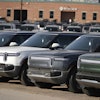Handling materials on docks can often require the assistance of an electric lift truck, such as a pallet truck or counterbalanced truck. Lift trucks can make it quicker and easier to load and unload trailers or rail cars, and to efficiently transport cases and pallets. However, when using lift trucks in the dock environment, it is important to follow proper operating procedures to avoid damage to products, docks and lift trucks, and to help maximize productivity.
- When unloading trailers or rail cars through a dock door, set proper precautions by ensuring the trailer or rail car brakes are locked. Blocks should be placed in front of or behind the wheels to prevent the trailer from rolling when the lift truck is driven into it.
- Use dock levelers to lift tractor trailers to meet the openings of dock doors. Check to be sure the trailer and the dock door are as level as possible before driving the lift truck through the dock door.
- When using dockboards to create a ramp between the dock floor and a trailer, verify the boards can support the loaded lift truck by checking the carrying capacity marked on the boards. Ensure the dockboards are securely anchored to prevent slippage.
- Inspect the floors of trailers and rail cars to confirm they are in good condition and have the capacity to support the loaded weight of a lift truck. Check trailer and dock floors to be sure they are clear of debris that can damage lift truck tires or cause tipping conditions.
- Check for pedestrians or other lift trucks when coming out of a blind area, such as a trailer. Stop the lift truck and sound the horn when crossing aisles or when visibility is obstructed. Ensure the load does not obstruct visibility and maintain a clear view of the path of travel during lift truck operation.
- Do not use lift trucks to handle unstable, loosely stacked or oversized loads. Place the lift truck forks into pallets as far as possible and make sure the forks are completely under the load for stability.
- Travel with the forks as low as possible when the forks are empty. Be sure the forks are raised enough, however, to clear any uneven floor conditions and ramp surfaces.


















